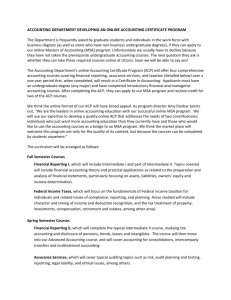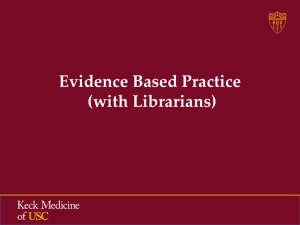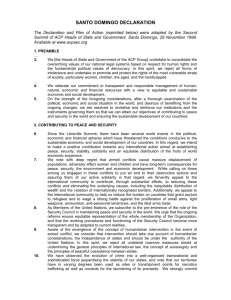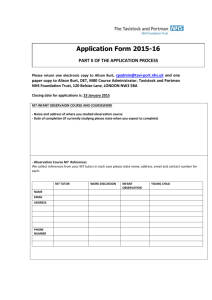Barriers and Strategies to an Iterative Model of Advance Care... Communication
advertisement
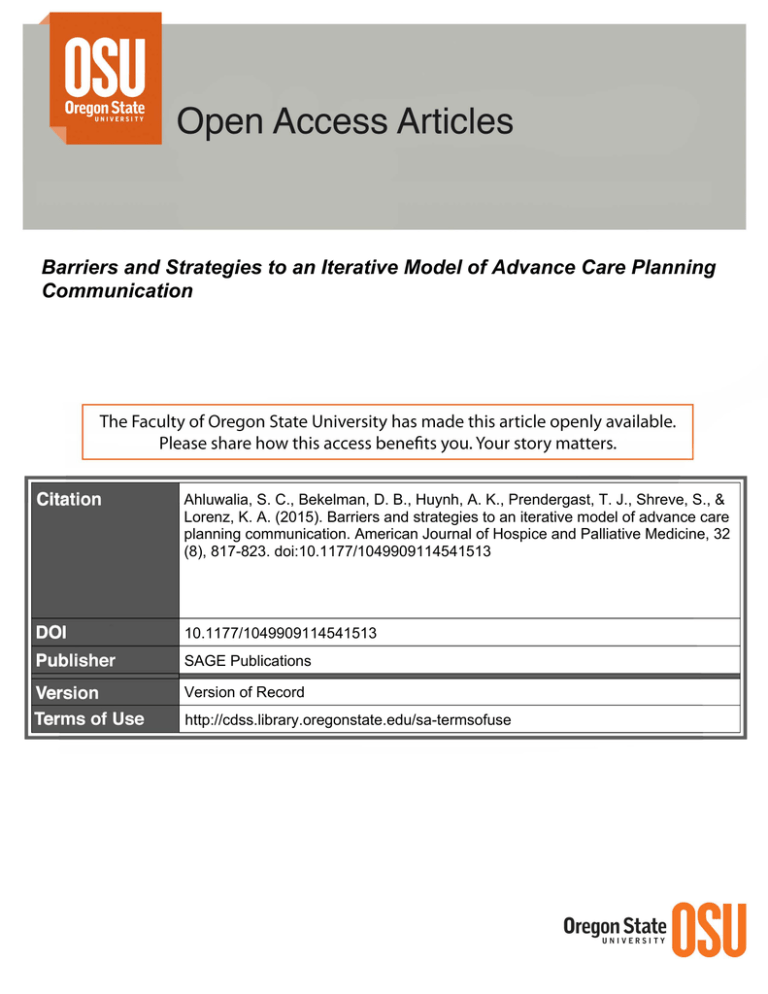
Barriers and Strategies to an Iterative Model of Advance Care Planning Communication Ahluwalia, S. C., Bekelman, D. B., Huynh, A. K., Prendergast, T. J., Shreve, S., & Lorenz, K. A. (2015). Barriers and strategies to an iterative model of advance care planning communication. American Journal of Hospice and Palliative Medicine, 32 (8), 817-823. doi:10.1177/1049909114541513 10.1177/1049909114541513 SAGE Publications Version of Record http://cdss.library.oregonstate.edu/sa-termsofuse Original Article Barriers and Strategies to an Iterative Model of Advance Care Planning Communication American Journal of Hospice & Palliative Medicine® 2015, Vol. 32(8) 817-823 ª The Author(s) 2014 Reprints and permission: sagepub.com/journalsPermissions.nav DOI: 10.1177/1049909114541513 ajhpm.sagepub.com Sangeeta C. Ahluwalia, PhD, MPH1,2, David B. Bekelman, MD, MPH3,4, Alexis K. Huynh, PhD, MPH2, Thomas J. Prendergast, MD5,6, Scott Shreve, DO7, and Karl A. Lorenz, MD, MSHS2,8 Abstract Background: Early and repeated patient–provider conversations about advance care planning (ACP) are now widely recommended. We sought to characterize barriers and strategies for realizing an iterative model of ACP patient–provider communication. Methods: A total of 2 multidisciplinary focus groups and 3 semistructured interviews with 20 providers at a large Veterans Affairs medical center. Thematic analysis was employed to identify salient themes. Results: Barriers included variation among providers in approaches to ACP, lack of useful information about patient values to guide decision making, and ineffective communication between providers across settings. Strategies included eliciting patient values rather than specific treatment choices and an increased role for primary care in the ACP process. Conclusions: Greater attention to connecting providers across the continuum, maximizing the potential of the electronic health record, and linking patient experiences to their values may help to connect ACP communication across the continuum. Keywords advance care planning, goals of care, patient preference, electronic health record, continuity of care, primary health care Background Advance care planning (ACP), a key element and an evidencebased best practice of quality palliative care,1 helps ensure patients receive care aligned with their wishes throughout the course of a life-limiting illness. Although ACP has typically centered on the completion of advance directives (ADs),2 it has been more broadly conceptualized as an iterative process of consideration and communication of health care values and goals between patients and family members and their providers.3-8 Prior research has shown that patient–provider ACP communication is associated with preference–concordant care9 and decreased utilization of intensive interventions10-13 at the end of life (EOL) and with greater patient/family satisfaction with EOL care.9 Several professional societies now recommend providers have multiple ACP discussions with their patients over the course of a serious illness,14-17 to allow adequate time for patients to plan for their future, help them articulate care preferences early in the trajectory, and routinely reevaluate and build upon those preferences through changing clinical experience.18,19 Despite this recent support of ACP as an iterative process, there are likely significant barriers to operationalizing such a model in clinical practice. Patients with advanced illness are typically cared for by multiple providers across a range of health care settings,20 underscoring the need to efficiently transfer and translate ACP information across settings and clinical scenarios. Although palliative care specialists are well positioned to support the ACP process, workforce limitations and growing recognition of the importance of upstream palliative care and early ACP portend a critical new role for providers across the continuum of care. Prior work has uncovered several individual-level barriers to engaging in ACP discussions,21-25 but less is known about potential systems-level barriers to realizing an iterative model of ACP. The Veterans Affairs (VA) health system has a strong track record of providing timely and high-quality palliative services to its patients.26-28 We sought VA providers’ perspectives on barriers and strategies for realizing an iterative model of ACP, 1 Oregon State University, Corvallis, OR, USA VA Greater Los Angeles Healthcare System, Los Angeles, CA, USA 3 Department of Veterans Affairs, Eastern Colorado Health Care System, Denver, CO, USA 4 School of Medicine, University of Colorado, Anschutz Medical Campus, Aurora, CO, USA 5 Portland VA Medical Center, Portland, OR, USA 6 Oregon Health and Science University, Portland, OR, USA 7 Lebanon VA Medical Center, Lebanon, PA, USA 8 Geffen School of Medicine at UCLA, Los Angeles, CA, USA 2 Corresponding Author: Sangeeta C. Ahluwalia, PhD, MPH, Oregon State University, College of Public Health and Human Sciences, 418 Waldo Hall, Corvallis, OR 97331, USA. Email: sangeeta.c.ahluwalia@oregonstate.edu Downloaded from ajh.sagepub.com at OREGON STATE UNIV LIBRARY on December 10, 2015 American Journal of Hospice & Palliative Medicine® 32(8) 818 Table 1. Focus Group Participants. Department, n Discipline, n Internal medicine Subspecialty Hospitalist ICU Palliative care/ethics Total by discipline, n 3 1 1 0 5 2 0 0 0 2 3 1 0 1 5 3 0 0 0 3 2 1 1 1 5 13 3 2 2 20 Physician Nursing Social work Chaplaincy Total by department, n Abbreviation: ICU, intensive care unit. using multidisciplinary focus groups to span the settings and providers that are usually considered separately when evaluating this complex communication task. Methods Setting and Data Source The VA, one of the largest integrated systems in the United States,29 offers a context primed to evaluate the potential for an iterative model of ACP. As part of a quality improvement (QI) effort to develop a national palliative care clinical template that included ACP documentation, we conducted a qualitative, cross-sectional evaluation of health care providers’ experiences, perspectives, and practices regarding the ACP process. We chose multidisciplinary focus groups to facilitate expression of differing perspectives through participant interaction and to inform a comprehensive picture of ACP across the continuum of care. This evaluation was conducted as a QI project and exempted from human subjects permissions by the VA Greater Los Angeles and Portland human subjects review committees. Participants We recruited a convenience sample of providers for 2 scheduled focus groups at a single VA medical center. We sought representation by discipline (internal medicine, geriatrics, hospital/intensive care, and palliative care) and role (physicians, nurses, social workers, and chaplaincy). We solicited participation through department-wide e-mails and by personal outreach to the chairs of the clinical services to identify potential participants. A snowball sampling approach was employed to identify additional participants. Interested participants self-selected the most convenient focus group to attend. Due to focus group size considerations, recruitment concluded when 20 participants had been scheduled. Of note, 3 of the 20 providers were unable to attend either scheduled focus group but participated instead in separate one-on-one telephone interviews. review of the literature on ACP30 and subsequently refined through an iterative, consensus-based process among team members. Questions in the guide addressed provider definitions and approaches to ACP, experiences engaging in ACP with patients and families, difficulties encountered, and perspectives on gaps and ways to improve the ACP process. Focus groups and interviews were facilitated by one of the authors (SCA), audiotaped, and lasted 1 to 1.5 hours each. Focus groups and interviews were professionally transcribed. The focus group facilitator (SCA) read through all transcripts in their entirety, and where not specified within participant dialogue, attributed discipline and role to each participant. An initial coding scheme was developed using the focus group guide as the framework.31 Using this scheme, the first focus group transcript was coded independently by 2 authors (SCA and AKH) who refined the scheme to reflect emerging codes. The transcript was recorded independently by both the authors using the refined scheme, with a second meeting to further refine the scheme. This process was iterated until consensus was reached on a final coding scheme that was applied to the transcripts by a single analyst (AKH). Trustworthiness in the analytic process was maintained through (1) regular audits of the coding process by SCA and (2) regular meetings to clarify codes and discuss and resolve discrepancies. We compared codes within and across transcripts to identify larger categories and the relationships between them to develop a set of themes that integrated the categories. All qualitative analysis was conducted using ATLAS.ti Scientific Software, V6.0.15. Results Twenty providers representing internal medicine, specialty medicine, hospital medicine, intensive care, and palliative care participated in 2 focus groups (n ¼ 17) or individual interviews (n ¼ 3; Table 1). We identified 5 themes highlighting challenges and solutions to realizing an iterative model of ACP. Challenges Data Collection and Analysis A semistructured facilitator guide was developed to moderate the 2 focus group discussions and 3 telephone interviews (Appendix A). An initial guide was drafted based on our prior Theme A1: Variation in definitions of ACP. Providers differed in how they defined and approached ACP by their discipline and practice setting. Providers earlier in the care continuum, for example, primary care, described ACP much more broadly Downloaded from ajh.sagepub.com at OREGON STATE UNIV LIBRARY on December 10, 2015 Ahluwalia et al 819 than acute care providers closer to the EOL, for example, intensive care, and consequently identified different types of ACP tasks. For example, internists described ACP as a comprehensive process of life planning, including such tasks as retirement preparation and financial planning, while hospitalists and intensivists focused more narrowly on EOL decisions: often lacked the in-depth knowledge of a patient’s personal history and values that primary care providers (PCPs) developed over the course of their ongoing relationship with the patient, and that there was no way to effectively communicate with the PCP to access that information and guide in-the-moment decision making. ‘‘[ACP] includes things like, where are you gonna live, what’s your retirement gonna look like, what are your support services, what kinds of things do you need to make your life livable before you get to the point that you need to fill out an [AD].’’ (Internist) ‘‘I think that highlights the poor communication we have for the inpatient/outpatient side. Maybe when the guy’s here in the hospital we should do a better job of calling primary care and saying, ‘Can you come and participate in this conversation?’ I think we ought to do a better job of trying to bring the providers who know the patient best to the bedside.’’ (Hospitalist) ‘‘We’re most concerned with code status and code status only . . . I would say the ACP that goes on in the ICU is whether they are DNR or not.’’ (Intensivist 2) ‘‘Yeah, I think we’re certainly focused on the bottom line.’’ (Intensivist) Theme A2: Lack of useful information about patient values to guide decision making. Providers expressed frustration over the absence or inaccessibility of information about a patient’s health care values and goals and described this gap as a function of current approaches to capturing ACP information. Specifically, they discussed how traditional ADs captured choices regarding specific interventions that were only applicable to a narrow set of unrealistic and unlikely scenarios without room for detail about a patient’s broader values that could more usefully be applied across a range of clinical situations. ‘‘It’s a box they have to check, right? So the guy says ‘Do everything’ and you say ‘alright sir, that means full code, right’ and they probably didn’t mean ‘chop-my-head-off-and-put-it-in-a-freezereverything.’ They mean some sort of realistic goal; ‘I want it if I can go back to some sort of quality of life.’ There’s a whole lot more nuance than saying ‘do all this stuff.’’’ (Hospitalist) ‘‘It’s yes, it’s no, it’s situations that never happen. It’s ‘if everybody in the whole world agrees I’m gonna die tomorrow, then yes, let me go.’ That’s not the way it works and that’s why I never look at ‘em,’ cause the questions asked aren’t useful.’’ (Internist) Providers also discussed how the structure of the electronic medical record (EMR) discouraged more robust documentation of patient values and goals, in particular because it was designed to capture point-of-care events rather than a more unified narrative about the patient’s health. ‘‘I think the biggest problem is with the current health record . . . they are all based on episodic care models where that ontology is the point of care and it completely fragments the narrative about the patient. And you cannot extract that story. It’s locked into the chart.’’ (Hospitalist) Theme A3: Ineffective communication between providers across settings. Providers described poor communication with each other as another reason for the lack or inaccessibility of useful ACP information. Hospitalists in particular described how they ‘‘I think one of the largest barriers is we’re so big as an institution and so silo-ed in terms of our structure that we don’t know each other like we used to. It’s not easy to call somebody you don’t know and you’re afraid you’re interrupting them, and it’s asking to see your patient.’’ (Hospitalist) Opportunities Theme B1: Eliciting patient values rather than specific treatment choices. Inpatient providers often suggested that having information about a patient’s broader values and goals for health care would be more useful for guiding care over the trajectory of an illness than specific treatment decisions that are often highly context dependent. ‘‘I think a values statement—what do you treasure in life? What would you not be willing to give up? I think those sorts of things are very helpful to providers about figuring out how far do we go with what we have available.’’ (Intensivist) ‘‘What I want is for an ACP document to be about your life and what gets you through the day, what you look forward to. That would be a million times more helpful than those box-based forms.’’ (Hospitalist) Theme B2: Increased but supported role for primary care in ACP process. Both primary and acute care providers suggested that ACP was best initiated in the outpatient setting by the PCP, given the depth of knowledge they have of their patients. However, this enthusiasm for a greater primary care role was tempered by the acknowledgment that additional workload without attendant support would make this a difficult solution to implement. ‘‘And most of us in primary care, if we’ve worked with a patient for three, four or five years or longer, we have a pretty good sense of where that patient wants to be going . . . a pretty good sense of what treatment options are most compatible with their goals. But we don’t do much in terms of communication. And I think the main thing is the volume of work.’’ (Primary Care) ‘‘We’re often thrown into a situation where I don’t know this patient, but I’m supposed to have this conversation about this most intimate and important topic. Most hospitalists feel that it’s a better thing to talk about in primary care. And my guess is most primary Downloaded from ajh.sagepub.com at OREGON STATE UNIV LIBRARY on December 10, 2015 American Journal of Hospice & Palliative Medicine® 32(8) 820 care people feel that way too. I think it’s that they don’t have the time.’’ (Hospitalist) As part of this discussion, some providers suggested alternate approaches to outpatient ACP, including better integration with palliative care and group ACP visits. ‘‘Sometimes I feel that I can’t give the family the face-time that they need to work through [family disagreement about goals]. So adding palliative care in the mix is helpful.’’ (Primary Care) ‘‘I think it’s helpful for this to happen in an outpatient setting. You could have a group visit where somebody talks about what goals of care would mean to people with similar diagnoses, and expectations about what can happen in the future.’’ (Intensivist) Discussion We took the approach of examining ACP as an iterative process that occurs over time and across settings and uncovered important barriers to realizing this model, including differences in providers’ approaches to ACP, the absence or inaccessibility of useful ACP information, and inadequate communication between inpatient and outpatient providers about ACP. Providers also identified opportunities for improving ACP across the health care system, such as the use of values statements to guide clinical decision making across multiple scenarios, and leveraging primary care for eliciting meaningful ACP information. Our findings can be used to guide the development of systems-level interventions in integrated health systems where palliative care services play a facilitative role to support an iterative model of ACP. Additional research examining ACP as an iterative process rather than as a set of discrete tasks will be needed to guide meaningful improvements in the process. Our findings suggest ACP is poorly integrated across the care continuum, with providers describing distinct ACP tasks by setting. To better support the decision-making process and guide patient-centered care throughout the trajectory of an illness, it will be critical to integrate the different pieces of ACP information gathered at each stage of an illness. One approach, broadly supported by providers in our focus groups, might be to establish a baseline understanding of a patient’s health care values early in the illness trajectory when patients can consider and articulate their preferences without the exigency of an acute situation. This baseline understanding could then be reevaluated in the context of the patient’s changing clinical experience through the illness trajectory,18 applying broad health care values to specific clinical events5 and used to undergird in-the-moment decision making across multiple scenarios. The focus on health care values that can be generalized across clinical contexts also addresses some of the limitations of traditional ADs, which are focused on specific, context-dependent choices.2,32-35 Prior work has shown the use of a values history36 that captures what is broadly important to a patient about their health, can help surrogates navigate complex treatment decisions,37 or indicate a care plan not covered by a traditional AD alone.38 The success and sustainability of such a model are likely to require adequate and repeated elicitation of patient values with consistent documentation. Palliative care providers may play an important role in helping to train other providers to elicit values information in a consistent and empathic manner from their patients. Providers also highlighted the need for improved communication across the outpatient–inpatient boundary to support iterative ACP. With increasing policy attention and financial incentives being given to the meaningful use of health care informatics,39-41 the EMR can play a key role in improving communication and information transfer across settings. Electronic medical record-based interventions to support an iterative ACP process might include standardized ACP documentation templates, electronic health information exchange (eg, electronic notification of a hospitalized patient) between providers, and clinical reminders to reengage patients in ACP at sentinel health care events. There is some evidence outside the ACP context to suggest such interventions are feasible to implement,42-48 and future work might focus on increasing consistent use of the EMR for ACP documentation to support communication and information transfer across settings. This study provides an initial look into some of the challenges and potential solutions for operationalizing an iterative model of ACP. Our sample size limits the scope of our findings. As part of a larger QI initiative, we were unable to be more expansive in our sampling; it is possible that had we conducted additional focus groups until reaching thematic saturation, we may have uncovered other challenges and solutions to an iterative model of ACP. In addition, our sampling approach led to greater physician attendance in the focus groups than other roles, thus it is likely that our findings primarily represent physician perspectives. Our findings also represent the perceptions of providers at a single VA site, which limits their generalizability to other contexts. As an integrated health care system with an established EMR, there are likely to be fewer perceived barriers to operationalizing ACP as an iterative process than there might be in nonintegrated systems. Still, we believe that our attempt to understand the challenges to operationalizing a model of ACP that is being increasingly recommended by professional societies provides direction for future research and clinical practice improvement in the area of ACP communication. Advance care planning is critical to assuring that patients receive care consistent with their values throughout the trajectory of an illness, yet there remain considerable challenges to operationalizing an iterative process of consideration and articulation of patient preferences through changing clinical experience. Greater attention to connecting providers across the care continuum and linking patient experiences to their values may help to integrate ACP communication and thus facilitate preference–concordant care throughout the course of an illness. Downloaded from ajh.sagepub.com at OREGON STATE UNIV LIBRARY on December 10, 2015 Ahluwalia et al 821 c) Appendix A Focus Group Facilitator Guide Q1: Describe What Advance Care Planning Means to You Probes a) What are some key ELEMENTS of advance care planning (eg, advance directives/other formal documentation, prognosis discussion) b) What are your GOALS for advance care planning (eg, to complete a physician order; to understand patient preferences)? c) What are desired OUTCOMES of advance care planning? Q2: What Types of Patients Would Benefit from Advance Care Planning? Who Needs an Advance Care Plan? Probes a) What illness CHARACTERISTICS might suggest a need for advance care planning (eg, diagnosis, stage, comorbidity;) ‘‘Chronic’’ versus ‘‘terminal’’ illness b) Are there SENTINEL EVENTS might suggest a need for advance care planning (eg, hospitalization, illness exacerbation, family conflict) Q3: When Should an ACP First be Discussed? When Should an ACP be Revisited? Probes a) What periodicity? b) Does this differ across patient types (eg, chronic illness vs. imminently terminal?) Q4: Describe Your Current Practices and Processes Around Advance Care Planning Probes a) Are there scripts or standardized approaches that you utilize? b) Are there certain steps that you undertake when discussing or putting together a care plan? c) Does this differ across patient types (eg, chronic illness vs. imminently terminal?) d) What would a template for advance care planning look like? What would a template for a care plan include? Q5. What are Some Difficulties You’ve Faced in Developing/ Discussing an Advance Care Plan? Probes a) Communication barriers (eg, content, language, affect) b) Knowledge barriers (eg, patient understanding of disease, family conflict, MD knowledge of ACP) Systems barriers (eg, transfers across setting and time, standardized documentation) Q6: What Tools or Resources do You or Have You Used to Assist you With Advance Care Planning? Q7: What Tools or Resources Would be Useful at the Point-ofCare to Assist You with ACP? Probes a) Communication tools (eg, scripts, plans, reminders) b) Tools to help you identify patients c) Documentation tools Authors’ Note This research was presented at the Hamolsky Award Session at the 2013 Society for General Internal Medicine Annual Meeting, Denver, CO, USA. Declaration of Conflicting Interests The author(s) declared no potential conflicts of interest with respect to the research, authorship, and/or publication of this article. Funding The author(s) disclosed receipt of the following financial support for the research, authorship and/or publication of this article: This work was supported by the Department of Veterans Affairs Comprehensive End-of-Life Care Initiative, Office of Patient Care Services. Dr Ahluwalia is supported in part by a Career Development Grant from the National Palliative Care Research Center. The preparation of this article was supported in part by the Implementation Research Institute (IRI), at the George Warren Brown School of Social Work, Washington University in St Louis, through the National Institute of Mental Health (R25 MH080916-01A2) and the Department of Veterans Affairs, Health Services Research & Development Service, Quality Enhancement Research Initiative (QUERI). References 1. Ferrell B, Connor SR, Cordes A, et al. The national agenda for quality palliative care: the national consensus project and the national quality forum. J Pain Symptom Manage. 2007;33(6): 737-744. 2. Gillick MR. Advance care planning. N Engl J Med. 2004;350(1): 7-8. 3. Gillick MR. A broader role for advance medical planning. Ann Intern Med. 1995;123(8):621-624. 4. Kolarik RC, Arnold RM, Fischer GS, Tulsky JA. Objectives for advance care planning. J Palliat Med. 2002;5(5):697-704. 5. Sudore RL, Fried TR. Redefining the ‘‘planning’’ in advance care planning: preparing for end-of-life decision making. Ann Intern Med. 2010;153(4):256-261. 6. Hickman SE, Hammes BJ, Moss AH, Tolle SW. Hope for the future: achieving the original intent of advance directives. Hastings Cent Rep. 2005;Spec No:S26-S30. 7. Goodlin SJ, Quill TE, Arnold RM. Communication and decisionmaking about prognosis in heart failure care. J Card Fail. 2008; 14(2):106-113. Downloaded from ajh.sagepub.com at OREGON STATE UNIV LIBRARY on December 10, 2015 American Journal of Hospice & Palliative Medicine® 32(8) 822 8. Singer PA, Martin DK, Lavery JV, Thiel EC, Kelner M, Mendelssohn DC. Reconceptualizing advance care planning from the patient’s perspective. Arch Intern Med. 1998; 158(8):879-884. 9. Detering KM, Hancock AD, Reade MC, Silvester W. The impact of advance care planning on end of life care in elderly patients: randomised controlled trial. BMJ. 2010;340:c1345. 10. Wright AA, Zhang B, Ray A, et al. Associations between end-oflife discussions, patient mental health, medical care near death, and caregiver bereavement adjustment. JAMA. 2008;300(14): 1665-1673. 11. Mack JW, Cronin A, Keating NL, et al. Associations between end-of-life discussion characteristics and care received near death: a prospective cohort study. J Clin Oncol. 2012;30(35): 4387-4395. 12. Lilly CM, De Meo DL, Sonna LA, et al. An intensive communication intervention for the critically ill. Am J Med. 2000;109(6): 469-475. 13. Lilly CM, Sonna LA, Haley KJ, Massaro AF. Intensive communication: four-year follow-up from a clinical practice study. Crit Care Med. 2003;31(5 suppl):S394-S399. 14. American Thoracic Society/European Respiratory Society Task Force. Standards for the Diagnosis and Management of Patients with COPD [Internet]. Version 1.2. New York: American Thoracic Society; 2004. [Updated September 8, 2005]. http://www. thoracic.org/go/copd. Accessed march 18, 2014. 15. Allen LA, Stevenson LW, Grady KL, et al. Decision making in advanced heart failure: a scientific statement from the American Heart Association. Circulation. 2012;125(15):1928-1952. 16. National Consensus Project for Quality Palliative Care Clinical practice guidelines for quality palliative care. http://www.nationalconsensusproject.org/Guidelines_Download2.aspx. Accessed January 30, 2014. 17. Detterbeck FC, Lewis SZ, Diekemper R, Addrizzo-Harris D, Alberts WM. Executive summary: diagnosis and management of lung cancer, 3rd ed: American college of chest physicians evidence-based clinical practice guidelines. Chest. 2013;143(5 suppl):7S-37S. 18. Ditto PH, Jacobson JA, Smucker WD, Danks JH, Fagerlin A. Context changes choices: a prospective study of the effects of hospitalization on life-sustaining treatment preferences. Med Decis Making. 2006;26(4):313-322. 19. Ditto PH, Smucker WD, Danks JH, et al. Stability of older adults’ preferences for life-sustaining medical treatment. Health Psychol. 2003;22(6):605-615. 20. Teno JM, Gozalo PL, Bynum JP, et al. Change in end-of-life care for Medicare beneficiaries: site of death, place of care, and health care transitions in 2000, 2005, and 2009. JAMA. 2013;309(5):470-477. 21. Curtis JR, Patrick DL, Caldwell ES, Collier AC. Why don’t patients and physicians talk about end-of-life care? Barriers to communication for patients with acquired immunodeficiency syndrome and their primary care clinicians. Arch Intern Med. 2000; 160(11):1690-1696. 22. Tung EE, North F. Advance care planning in the primary care setting: a comparison of attending staff and resident barriers. Am J Hosp Palliat Care. 2009;26(6):456-463. 23. Gott M, Gardiner C, Small N, et al. Barriers to advance care planning in chronic obstructive pulmonary disease. Palliat Med. 2009; 23(7):642-648. 24. Morrison RS, Morrison EW, Glickman DF. Physician reluctance to discuss advance directives. an empiric investigation of potential barriers. Arch Intern Med. 1994;154(20): 2311-2318. 25. Schickedanz AD, Schillinger D, Landefeld CS, Knight SJ, Williams BA, Sudore RL. A clinical framework for improving the advance care planning process: start with patients’ self-identified barriers. J Am Geriatr Soc. 2009;57(1):31-39. 26. Edes T, Shreve S, Casarett D. Increasing access and quality in department of veterans affairs care at the end of life: a lesson in change. J Am Geriatr Soc. 2007;55(10):1645-1649. 27. Lu H, Trancik E, Bailey FA, et al. Families’ perceptions of endof-life care in veterans affairs versus non-veterans affairs facilities. J Palliat Med. 2010;13(8):991-996. 28. Walling AM, Tisnado D, Asch SM, et al. The quality of supportive cancer care in the veterans affairs health system and targets for improvement. JAMA Intern Med. 2013;173(22): 2071-2079. 29. Department of Veterans Affairs VHA, Office of the Assistant Deputy Under Secretary for Health for Policy and Planning. Selected Veterans Health Administration Characteristics: FY2002-FY2012 [Internet]. Washington, DC: US Department of Veterans Affairs. http://www.va.gov/VETDATA/utilization.asp. Accessed July 27, 2013. 30. Lorenz KA, Lynn J, Dy SM, et al. Evidence for improving palliative care at the end of life: a systematic review. Ann Intern Med. 2008;148(2):147-159. 31. Hsieh HF, Shannon SE. Three approaches to qualitative content analysis. Qual Health Res. 2005;15(9):1277-1288. 32. Brett AS. Limitations of listing specific medical interventions in advance directives. JAMA. 1991;266(6):825-828. 33. Teno J, Lynn J, Wenger N, et al. Advance directives for seriously ill hospitalized patients: effectiveness with the patient self-determination act and the SUPPORT intervention. SUPPORT investigators. Study to understand prognoses and preferences for outcomes and risks of treatment. J Am Geriatr Soc. 1997;45(4):500-507. 34. Fagerlin A, Schneider CE. Enough. The failure of the living will. Hastings Cent Rep. 2004;34(2):30-42. 35. Teno JM, Stevens M, Spernak S, Lynn J. Role of written advance directives in decision making: insights from qualitative and quantitative data. J Gen Intern Med. 1998;13(7):439-446. 36. Karel MJ, Powell J, Cantor MD. Using a values discussion guide to facilitate communication in advance care planning. Patient Educ Couns. 2004;55(1):22-31. 37. Scheunemann LP, Arnold RM, White DB. The facilitated values history: helping surrogates make authentic decisions for incapacitated patients with advanced illness. Am J Respir Crit Care Med. 2012;186(6):480-486. 38. Prommer EE. Using the values-based history to fine-tune advance care planning for oncology patients. J Cancer Educ. 2010;25(1):66-69. 39. DesRoches CM, Audet AM, Painter M, Donelan K. Meeting meaningful use criteria and managing patient populations: a Downloaded from ajh.sagepub.com at OREGON STATE UNIV LIBRARY on December 10, 2015 Ahluwalia et al 40. 41. 42. 43. 44. 823 national survey of practicing physicians. Ann Intern Med. 2013; 158(11):791-799. Wright A, Henkin S, Feblowitz J, McCoy AB, Bates DW, Sittig DF. Early results of the meaningful use program for electronic health records. N Engl J Med. 2013;368(8):779-780. Blumenthal D, Tavenner M. The ‘‘meaningful use’’ regulation for electronic health records. N Engl J Med. 2010;363(6):501-504. Gardner CL, Pearce PF. Customization of electronic medical record templates to improve end-user satisfaction. Comput Inform Nurs. 2013;31(3):115-121. Bonney W, Christie S, Paterson G, Thibault-Halman G, Alsulaiman A. Design and implementation of synoptic operative report template using interoperable standards. Stud Health Technol Inform. 2013;183:195-200. Wright A, Soran C, Jenter CA, Volk LA, Bates DW, Simon SR. Physician attitudes toward health information exchange: results 45. 46. 47. 48. of a statewide survey. J Am Med Inform Assoc. 2010;17(1): 66-70. Vest JR, Miller TR. The association between health information exchange and measures of patient satisfaction. Appl Clin Inform. 2011;2(4):447-459. Branger P, van’t Hooft A, van der Wouden HC. Coordinating shared care using electronic data interchange. Medinfo. 1995;8 pt 2:1669. Fung CH, Tsai JS, Lulejian A, Glassman P, Patterson E, Doebbeling BN, Asch SM. An evaluation of the veterans health administration’s clinical reminders system: a national survey of generalists. J Gen Intern Med. 2008;23(4):392-398. Fung CH, Woods JN, Asch SM, Glassman P, Doebbeling BN. Variation in implementation and use of computerized clinical reminders in an integrated healthcare system. Am J Manag Care. 2004;10(11 pt 2):878-885. Downloaded from ajh.sagepub.com at OREGON STATE UNIV LIBRARY on December 10, 2015


